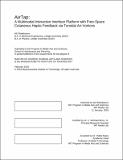| dc.contributor.advisor | V. Michael Bove, Jr. | en_US |
| dc.contributor.author | Shtarbanov, Ali | en_US |
| dc.contributor.other | Program in Media Arts and Sciences (Massachusetts Institute of Technology) | en_US |
| dc.date.accessioned | 2018-05-23T16:31:42Z | |
| dc.date.available | 2018-05-23T16:31:42Z | |
| dc.date.copyright | 2018 | en_US |
| dc.date.issued | 2018 | en_US |
| dc.identifier.uri | http://hdl.handle.net/1721.1/115718 | |
| dc.description | Thesis: S.M., Massachusetts Institute of Technology, School of Architecture and Planning, Program in Media Arts and Sciences, 2018. | en_US |
| dc.description | Cataloged from PDF version of thesis. | en_US |
| dc.description | Includes bibliographical references (pages 157-162). | en_US |
| dc.description.abstract | With recent developments in visual interface technologies, which are now capable of delivering rich and highly immersive experiences, the need has arisen to develop equally capable haptic-feedback technologies that can complement and be easily integrated with their visual counterparts to enable fully immersive, multimodal, interactive experiences. Moreover, with touchscreen devices rapidly replacing physical controls, as in the case of automobiles and industrial equipment, there has been a loss of natural haptic cues and an increased need for operators to divert their attention from the task at hand into the touchscreen just to find the locations of different controls - which previously they could feel by relying on haptic cues without having to employ the visual sense. This is especially concerning for drivers, where even a brief loss of attention could lead to catastrophic consequences. This work aims to begin addressing these problems by presenting an approach - based on air-vortex-ring, free-space haptics - that enables existing visual interfaces to be augmented with haptic feedback capabilities. After presenting our goals and motivations for this work, the latest approaches to haptic feedback interaction, and a discussion of the advantages and limitations of each approach, we describe the toroidal air-vortex approach to free-space haptics in full detail. We then present a multimodal interactive interface system that we built based on that approach, named AirTap, which is the main focus of this thesis. AirTap is an open-source system that uses 16 air-vortex-ring generators to deliver targeted, localized, unambiguous, free-space haptic feedback onto a user's hand when interacting with 3D virtual objects on a stereoscopic display. We show how AirTap can serve as a multimodal interactive interface, as a research tool for studying air-vortex-ring based haptics, and as an open platform for creative expressions. Finally, we provide an extensive discussion of how our system can be extended beyond its present form and adopted for automotive and other applications. | en_US |
| dc.description.statementofresponsibility | by Ali Shtarbanov. | en_US |
| dc.format.extent | 162 pages | en_US |
| dc.language.iso | eng | en_US |
| dc.publisher | Massachusetts Institute of Technology | en_US |
| dc.rights | MIT theses are protected by copyright. They may be viewed, downloaded, or printed from this source but further reproduction or distribution in any format is prohibited without written permission. | en_US |
| dc.rights.uri | http://dspace.mit.edu/handle/1721.1/7582 | en_US |
| dc.subject | Program in Media Arts and Sciences () | en_US |
| dc.title | AirTap : a multimodal interactive interface platform with free-space cutaneous haptic feedback via toroidal air-vortices | en_US |
| dc.title.alternative | Air Tap : a multimodal interactive interface platform with free-space cutaneous haptic feedback via toroidal air-vortices | en_US |
| dc.title.alternative | Multimodal interactive interface planform with free-space cutaneous haptic feedback via toroidal air-vortices | en_US |
| dc.type | Thesis | en_US |
| dc.description.degree | S.M. | en_US |
| dc.contributor.department | Program in Media Arts and Sciences (Massachusetts Institute of Technology) | en_US |
| dc.identifier.oclc | 1036986498 | en_US |
